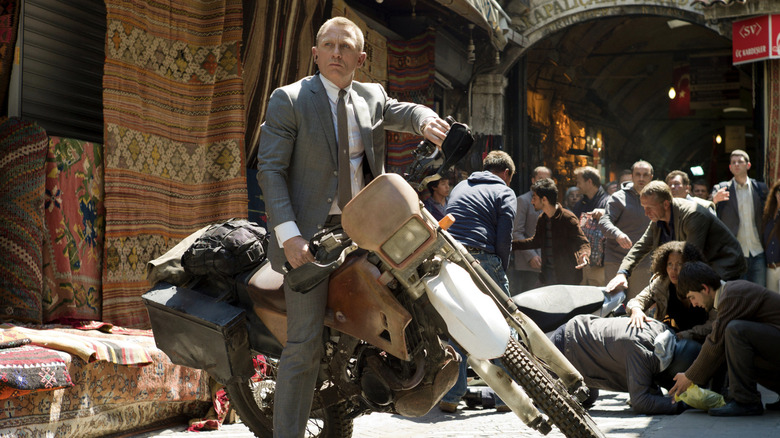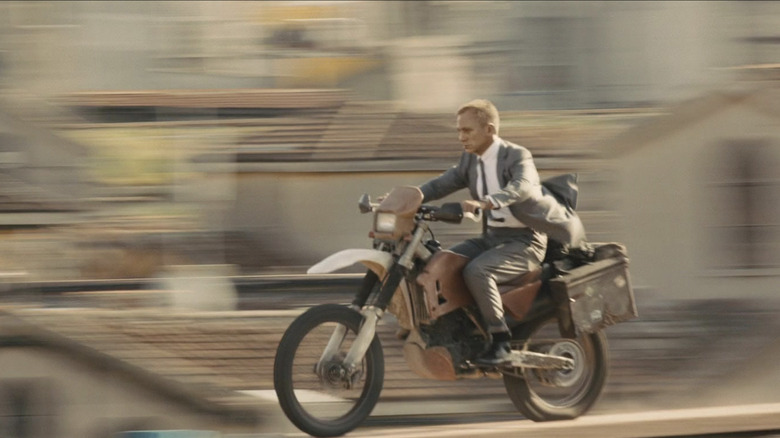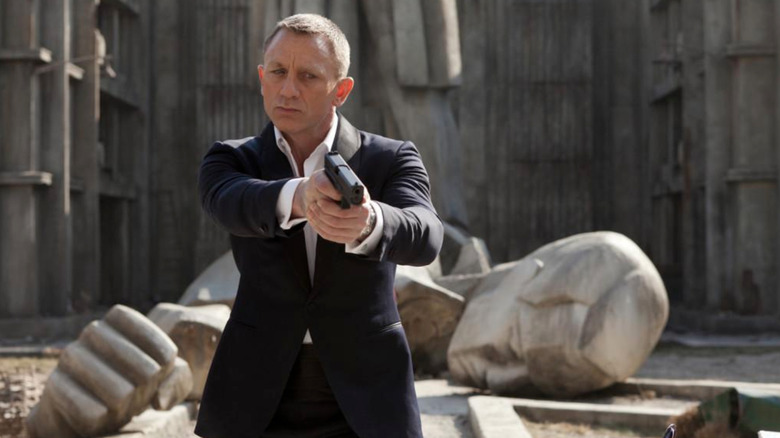How Skyfall Filmed That Crazy Opening Motorcycle Chase
2022 marks the 10th anniversary of the James Bond film "Skyfall," the first film in the franchise directed by Sam Mendes. Released the same year that the Avengers assembled for the first time and Christopher Nolan wrapped up his Dark Knight Trilogy, James Bond also had an explosive movie of his own. The third in the Daniel Craig series of 007 films, "Skyfall" sees Bond in a deadly game of cat-and-mouse with a burned MI-6 operative who has a vendetta against M (Judi Dench), the head of MI6. Skyfall" was praised upon its release for its politically relevant story and themes, beautiful cinematography, and of course, all the action you expect a James Bond film to come with.
The action in "Skyfall" can nearly give 2006's "Casino Royale" a run for its money. "Skyfall" opens up with an incredible chase sequence that sets the tone for the rest of the movie, and according to director Sam Mendes, filming it was a tremendous challenge. There are many moving pieces when it comes to filming a chase sequence, and not just on a practical level. When crafting the action of "Skyfall," Mendes carefully ensured that the action wasn't mindless and without purpose; instead, it had significance to the story.
A challenging weeks-long shoot
In the director's commentary for "Skyfall," Sam Mendes went into detail about all the different types of shots that went into making the opening chase sequence of the film as smooth as possible:
"In the end, it's a combination of stunt work shot on the roofs themselves, a camera helicopter, a green screen for the occasional closeup, head replacements, and all sorts of things used; hopefully, in the end, it seems pretty seamless. But given that, in fact, it was shot over a number of weeks, and the weather changed constantly, it is also brilliantly timed by Roger Deakins, obviously, our great cinematographer."
As seamless as the chase looks in the film's final cut, it makes sense that Mendes would shoot the different coverage of the pursuit over several weeks. Not only is this a testament to the stunt workers involved in the production, but as Mendes points out, Deakins played a considerable role in making it all look cohesive continuity-wise. The cinematography in "Skyfall" is filled with mesmerizing and artful shots, but there's also a technical aspect that's key in ensuring that action over one scene doesn't look disjointed despite being shot on entirely different days, which Deakins successfully accomplished with this opening chase.
Action that serves the story
The vast amount of interconnected shots and intricate choreography in the chase might have been the most challenging (and time-consuming) part. Still, Sam Mendes also wanted to ensure that the lengthy opening action sequence of "Skyfall" served a purpose. It's easy to lose the story in the grandiose production, but as long as the scene was, Mendes made sure to cut whatever wasn't necessary. He shared:
"The sequence ended up being around 11 minutes, something like that. Which is right on the edge of being too long, I felt. We were very hard on stuff that didn't seem necessary or outstayed its welcome — or in any way fetishized the action. There's a great tendency to be bigger, louder, faster, and to sort of forget the story, almost as if the story stops and the action begins, and the story doesn't start again until the action is over."
Mendes' critical understanding of how a good story elevates an action sequence helps make "Skyfall" a remarkable entry in the series of James Bond films. The explosive chase could've been meaningless, but it instead serves as a way for Bond to go into hiding and contemplate his relationship with M and M's questionable methods as the head of MI6. When putting together all the intricate moving pieces on a technical and thematic level, you get one of the best action sequences in a James Bond movie.


